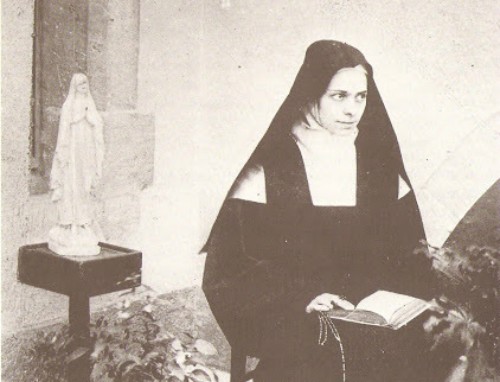
St Therese June 1897?
I have had this photo of St. Therese on my desk the last few months while I have worked from home. It has become my favorite picture of her. There is something about the look, a certain resolve, expression of concern, etc. that I find compelling. I usually take a break a few times a day just to stare at it a little while. This is strange, because I have my doubts whether the photo is even authentic. Perhaps you can solve the mystery for me?
It is a close up of a photo that I first saw in the book The Hidden Face: A Study of St. Therese of Lisieux, by Ida Friederike Gorres, which I purchased and read in March. It is hard to categorize the book. It is a study of the Saint’s time on earth, her spirituality, her canonization process, and the public reaction. It was originally published in 1959, and resissued in English by Ignatius Press in 2003. The book was a deliberate response to earlier biographies or portrayals of the Saint that the author believed were shallow or not a true representation of her life. I am not an expert on the Saint, so its possible that some of her findings have been eclipsed by more recent scholarship..
The author says the book was prompted in part, by a colleague sharing the above photo with her and a group of colleagues:
During a meeting at Burg Rothenfels, then the centre of the Catholic Youth Movement in Germany, a student showed me a small picture, like a passport photograph. “This is the true appearance of Little Thérèse”, he said. “Dom Willibrord Verkade, the monk-painter of Beuron, discovered and published it.
The Carmel at Lisieux, and a French bishop as well, protested vehemently against its publication.” A small group of young people gathered around him; the picture passed from hand to hand. In stunned silence we gazed at the familiar and yet so alien features, and someone said: “Almost like the face of a female Christ.” From that August morning on I was determined to pursue the riddle of her look and her smile—so different from the honeyed insipidity of the usual representations of her. Who was Thérèse of the Child Jesus in reality?
We have photographs of St. Therese as a nun because her birth sister, Celine Martin, brought a camera with her when she joined the Lisieux convent. As Sister Genevieve of the Holy Face (her name in religion), she took 40 + photos that included St. Therese. These photos may all be viewed at the online Lisieux archive at this website.
This photo corresponds to none of the photos in the Archive. It is well documented that St. Therese sat for a photo session on June 7, 1897, and the Archive includes three photos. But she is facing the other direction in all three.
I have not found any records of any other photographer being granted admission to the Carmel in June of 1897. I checked two autobiographies by Dom Willbrord Verkade, but he makes no mention of the Saint or any visit to Lisieux. Nor can I find any other source of information on his publication of the photo, how he came to have it, and the alleged controversy it produced.
It is well documented that Therese’s blood sisters were careful custodians of her writings and images for many years after her death. They were very reluctant to release unedited correspondence and photographs of her. I believe I read that Sister Genevieve was sometimes disappointed at her photos not capturing her true likeness, perhaps due to the Saint’s illness or fatigue. She separately made a number of paintings that she felt were a more true representation of how she appeared to her, perhaps before she got sick. She also retouched a number of the photos, which are also available at the Archive. One theory of mine is that Sister Genevieve flipped on the horizontal one of the three photos from June 7, 1897, and then retouched it. However, I do not even know if this was technically possible in 1897, and none of the other retouched photos shows that level of alteration. The closest match would be the photo below, which I have flipped (please note that this photo was found on the internet, and not taken from the Archive website. Those versions are copyrighted). But the photo in the book shows St. Therese against a completely gray background, which appears almost artificial, as opposed to the foliage in the picture below.

A horizontal flipped version of one of Sister Genevieve’s photos of Therese from June 7, 1897
Other possibilities:
- This was a genuine photo taken by Sister Genevieve that was stolen from the Carmel, which might explain the alleged controversy and why it does not appear in the Archive.
- Someone much later in time copied and altered one of Sister Genevieve’s photos, when it was technically possible to do so.
- There was another, unknown (at least to me) photographer who was given access to the Carmel and took the photo that appears in The Hidden Face.
If you know the answer, please share your comments. I may do another post about The Hidden Face in the near future, and how its discussion of Saint Therese might guide us in these difficult times.














You must be logged in to post a comment.